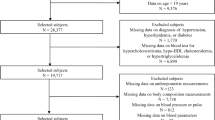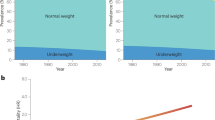Abstract
OBJECTIVE: To evaluate different aspects of obesity, such as body fat distribution, plasma hormone and lipid profiles, adipose tissue composition and dietary intake in an obese population in order to identify the most important factors that contribute to obesity.
DESIGN: Eighty-five obese subjects, 30 men and 55 women (age, 30–70 y; body mass index (BMI), 27–35 kg/m2), were studied using anthropometric measurements, computed tomography, adipose tissue composition, serum hormone and lipid profiles and nutritional evaluations. To determine to what extent individual factors contributed to the general process of obesity, the data were subjected to a factor analysis.
RESULTS: Three patterns of anthropometric and computed tomography data emerged that accounted for 69% of the variance. Factor 1 defined abdominal obesity and explained 30% of the total variance, factor 2 (gynoid obesity) accounted for 26%; and factor 3 (subcutaneous fat) explained 13% of the total variance. When other factors associated with obesity, such as lipid profile, hormonal profile and fat composition, were introduced, obesity itself, especially abdominal obesity, remained the principal factor, accounting for 23% of total variability. All factors were of secondary importance when dietary characteristics were introduced. In the overall factor analysis, more than 40% of the variability in obesity was related to dietary habits, particularly fat intake, followed by energy and saturated fatty acids intake.
CONCLUSION: Even though obesity is a multifactorial phenomenon, the results suggest that dietary intake, especially fat intake, is the most important factor contributing to obesity. Secondary factors include endocrine and metabolic factors.
This is a preview of subscription content, access via your institution
Access options
Subscribe to this journal
Receive 12 print issues and online access
$259.00 per year
only $21.58 per issue
Buy this article
- Purchase on Springer Link
- Instant access to full article PDF
Prices may be subject to local taxes which are calculated during checkout
Similar content being viewed by others
References
Reaven GM, Chen YDI . Role of insulin in regulation of lipoprotein metabolism in diabetes Diabetes Metab Rev 1988 4: 639–652.
Björntorp P . Visceral obesity a civilization syndrome Obes Res 1993 1: 206–222.
Björntorp P . The regulation of adipose tissue distribution in man Int J Obes Relat Metab Disord 1996 20: 291–302.
Schoeo RE, Evans KW, Sankey SS, Weissfeld JL, Kuller L . Does visceral adipose tissue differ from subcutaneous adipose tissue in fatty acid content? Int J Obes Relat Metab Disord 1996 20: 346–352.
Nestler JE, Barlascini CO, Clore JN, Baclard WG . Dehydroepiandrosterone reduces serum low density lipoprotein levels and body fat but does not alter insulin sensitivity in normal men J Clin Endocr Metab 1988 66: 57–61.
Mohamed-Ali V, Pinkney JH, Coppackt SW . Adipose tissue as an endocrine and paracrine organ Int J Obes Relat Metab Disord 1998 22: 1145–1158.
Carmena R, Ascaso J, Tebar FJ, Soriano J . Changes in plasma high density lipoproteins after body weight reduction in obese woman Int J Obes 1984 8: 135–140.
Siri WE . Body composition from fluid spaces and density: analysis of methods. In: Brozek J, Henschel A (eds). Techniques for Measuring Body Composition National Academy of Sciences: Washington DC 1961 223–244.
Sjöström L . A computer tomography based multicompartment body composition technique and anthropometric prediction of lean body mass, total and subcutaneous adipose tissue Int J Obes 1991 15: 19–30.
Ross R, Shaw KD, Rissanen J, Martel Y, De Guise J, Avruch L . Sex differences in lean and adipose tissue distribution by magnetic resonance imaging: anthropometric relationships Am J Clin Nutr 1994 59: 1277–1285.
Bingham SA, Gill C, Welch A, Day K, Cassidy A, Khaw KT et al. Comparison of dietary assessment methods in nutritional epidemilogy: weight recors vs 24 h recalls, food frequency questionnaires and estimated-diet records Br J Nutr 1994 7: 619–643.
Lepage G, Roy CC . Direct transesterification of all classes of lipids in a one-step reaction J Lipid Res 1986 27: 114–120.
BMDP Statistical Software. University of California Press: London 1985.
Alastrue A, Rull M, Camps I, Ginesta C, Melus MR, Salvá JA . Nuevas normas y consejos en la valoración de los parámetros antropométricos en nuestra población: Índice adiposo-muscular, índices ponderalés y tablas de percentiles de los datos antropométricos útiles en una valoración nutricional Med Clín 1988 91: 223–236.
Matsuzawa Y, Fujioka S, Tokunaga K, Tauri S . A novel classification: visceral fat obesity and subcutaneous fat obesity. In: Berry EM, Blondheim SH, Eliahou HE, Shafrir E (eds) Recent Advances in Obesity Research: V. Proceedings of the 5th International Congress on Obesity Libbey: London 1986 92–96.
De Pergola G, Giagulli VA, Garruti G, Cospite MR, Giorgino F, Cignarelli M, Giorgino R . Low dehydroepiandrosterone circulating levels in premenopausal obese women with very high body mass index Metabolism 1991 40: 187–190.
Lea-Currie YR, Wen P, McIntosh MK . Dehydroepiandrosterone-sulfate (DHEAS) reduces adipocyte hyperplasia associated with feeding rats a high-fat diet Int J Obes Relat Metab Disord 1998 49: 421–432.
Morales AJ, Haubrich RH, Hwang JY, Asakura S, Yen SS . The effect of six months treatment with 100 mg daily dose of dehydroepiandrosterone (DHEA) on circulating sex steroids, body composition and muscle strength in age-advanced men and women Clin Endocrinol 1998 49: 421–432.
Kern PA, Saghizadeh M, Ong JM, Bosch RJ, Deem R, Simsolo RB . The expression of tumor necrosis factor in human adipose tissue. Regulation by obesity, weight loss, and relationship to lipoprotein lipase J Clin Invest 1995 95: 2111–2119.
Hotamisligli GS, Amer P, Caro JF, Atkinson RL, Spiegelman BM . Increased adipose tissue expression of tumor necrosis factor-alpha in human obesity and insulin resistance J Clin Invest 1995 95: 2409–2415.
Donahoo WT, Eckel RH . Adipocyte metabolism in obesity Curr Opin Endocrinol Diabetes 1996 3: 501–507.
Considine RV, Caro JF . Leptin and the regulation of body weight Int J Biochem Cell Biol 1997 29: 1255–1272.
Tormo MJ, Navarro C, Chirlaque MD, Pérez D . Factores de riesgo cardiovascular en la Región de Murcia, España Revista Española Salud Pública 1997 71: 515–529.
Pollare T, Vessby B, Lithell H . Lipoprotein cholesterol and triglyceride concentration in men Arterioscler Thromb 1991 11: 1192–1203.
Departamento de Nutrición . Tablas de ingestas recomendadas de energía y nutrientes para la población Española Departamento de Nutrición: Madrid 1998.
Garaulet M, Martinez A, Victoria F, Pérez-Llamas F, Ortega R, Zamora S . Differences in dietary intake and activity level between normal weight and overweight/obese adolescents J Pediatr Gastr Nutr 2000 30: 253–258.
Ortega RM, Redondo MR, Zamora MJ, López-Sobaler AM, Andrés P . Eating behaviour and energy and nutrient intake in overweight/obese and normal-weight Spanish elderly Ann Nutr Metab 1995 39: 371–378.
Andersson I, Rossner S . The Gustaf study: repeated, telephone-administered 24-hour dietary recalls of obese and normal weight men: energy and macronutrient intake and distribution over the days of the week J Am Diet Assoc 1996 96: 686–692.
Lissner L, Levitsky DA. Strupp BJ, Kalkwarf HJ, Roe DA . Dietary fat and the regulation of energy intake in human subjects Am J Clin Nutr 1987 46: 886–892.
Garaulet M, Pérez-Llamas F, Rueda CM, Zamora S . Trends in the Mediterranean diet in children from south-east Spain Nutr Res 1998 18: 979–988.
Schoeo RE, Thaete FL, Sankey SS, Weissfeld JL, Kuller LH . Sagittal diameter in comparison with single slice CT as a predictor of total visceral adipose tissue volume Int J Obes Relat Metab Disord 1998 22: 338–342.
Zamboni M, Turcatol E, Armellini F et al. Sagittal abdominal diameter as a practical predictor of visceral fat Int J Obes Relat Metab Disord 1998 22: 655–660.
Willet WC, Dietz WH, Colditz GA . Guidelines for healthy weight New Engl J Med 1999 341: 427–434.
Thang S, Van Leer E, Seidell J, Lean M . Waist circumference as a screening tool for cardiovascular risk factors: evaluation of receiver operating characteristics (ROC) Obes Res 1996 4: 533–547.
Vague J . La differentiation sexuelle facteur determinant des formes de l'obesité Presse Med 1947 30: 339–340.
Haffner SM, Katz MS, Dunn JF . Increased upper body and overall adiposity is associated with decreased sex hormone binding globulin in postmenopausal women Int J Obes 1991 15: 471–478.
Xu X, De Pergola G, Björntorp P . The effects of androgens on the regulation of lipolysis in adipose precursors cells Endocrinology 1990 126: 1229–1234.
Shepher PR, Kanh BB . Glucose transporters and insulin action. Implications for Insulin resistance and Diabetes Mellitus New Engl J Med 1999 341: 248–257.
Fernández-Real JM, Broch M, Ricart W et al. Plasma levels of the soluble fraction of tumor necrosis factor receptor 2 and insulin resistance Diabetes 1998 47: 1757–1762.
Deprés JP . Dyslipidaemia and obesity J Clin Endocr Metab 1994 8: 629–660.
Shono N, Kumagai S, Higaki Y, Nishizumi M, Sasaki H . The relationships of testosterone, estradiol, dehydroepiandrosterone-sulfate and sex hormone-binding globulin to lipid and glucose metabolism in healthy men J Atheroscler Thromb 1996 3: 45–51.
Willet WC . Is dietary fat a major determinant of body fat? Am J Clin Nutr 1998 67: 556S–562S.
Hill J O . Dietary fat and obesity J Nutr 2000 130: 284–288.
Willet W C . Dietary fat and obesity: an unconvincing relation Am J Clin Nutr 1998 68: 1149–1150.
Seidell JC . Dietary fat and obesity: an epidemiologic perspective Am J Clin Nutr 1998 67: 546–550.
Acknowledgements
This study was supported by a grant from the Official College of Pharmacist of Murcia, Spain. We are indebted to Professor Per Björntorp from the Departments of Medicine and Heart and Lung diseases, Wallenger laboratory, Sahlgren's Hospital, University of Göteborg, Sweden, for advice regarding the scientific design of this project, and to the members of the laboratory, especially to Birguitta Odén, for the technical advice in the adipose tissue techniques. We also thank all the staff from the Surgery, Endocrinology, Radiology, Biochemistry and Nuclear Medicine Services from the Arrixaca Hospital, Murcia, Spain, for their skilled technical assistance.
Author information
Authors and Affiliations
Corresponding author
Appendix 1. Total variables measured
Appendix 1. Total variables measured
Population characteristics
Rights and permissions
About this article
Cite this article
Garaulet, M., Pérez-Llamas, F., Canteras, M. et al. Endocrine, metabolic and nutritional factors in obesity and their relative significance as studied by factor analysis. Int J Obes 25, 243–251 (2001). https://doi.org/10.1038/sj.ijo.0801476
Received:
Revised:
Accepted:
Published:
Issue Date:
DOI: https://doi.org/10.1038/sj.ijo.0801476
Keywords
This article is cited by
-
Chlamydophila pneumoniae antibodies may be independently associated with increased BMI and percentage of body fat among women
International Journal of Obesity (2011)
-
Dietary factors associated with obesity indicators and level of sports participation in Flemish adults: a cross-sectional study
Nutrition Journal (2007)
-
Adiposity and dietary intake in cardiovascular risk in an obese population from a Mediterranean area
Journal of Physiology and Biochemistry (2004)



